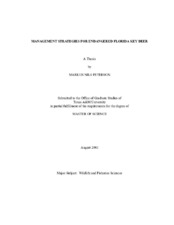| dc.description.abstract | Urban development is of particular concern in the management of endangered Key deer (Odocoileous virginianus clavium) because highway mortality is the greatest single cause of deer mortality (≈ 50%), and the rural community of Big Pine Key, Florida constitutes the majority of Key deer habitat. Study objectives were to provide and synthesize management strategies useful in the recovery of Key deer. Specifically, I (1) used simulation modeling to evaluate effects of fetal sex ratios (FSR) on Key deer population structure, (2) evaluated the most efficient and socially acceptable urban deer capture methods, (3) evaluated changes in fawn survival, mortality agents, and range size between 1968-2002, and (4) conducted an ethnography of the human population on Big Pine Key to ascertain cultural dynamics within the community and provide guidelines for community based management of Key deer.
Key deer were radio-collared (n = 335) as part of 2 separate field studies (1968-1972, 1998-2002), and mortality and survey estimates were collected throughout the entire period (1966-2002). During 1990-2002, I used an ethnographic approach to analyze the conflict surrounding Key deer management and explored how conflict and moral culture applied to this endangered species. These data were used to address my study objectives.
I found the most commonly cited FSR (2.67:1, male:female) for Florida Key deer to be inaccurate. A male biased FSR of 1.45:1 was more probable. Modified drop and drive nets were appropriate methods for urban deer capture because they are passive, silent, fast, generally accepted by the public, and yielded low mortality and injury rates. Between 1968-2002 Key deer fawn survival increased in tandem with human development while range sizes decreased. This suggests a positive, but not sustainable, relationship between fawn survival and development. I found disputants on Big Pine Key divided into 2 moral cultures, 1 grounded in stewardship and the other in private property rights. Successful management strategies for the Key deer require understanding and addressing issues at several levels including: Key deer demographics, community perspectives, and cultural norms. Collectively this information can be used by wildlife managers to improve the management and recovery of Key deer. | en |


